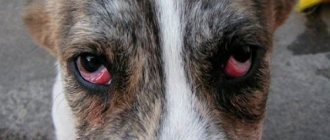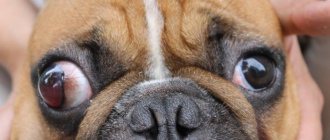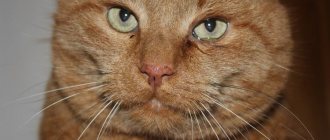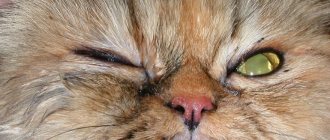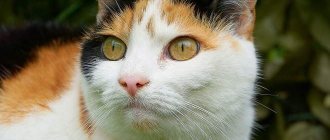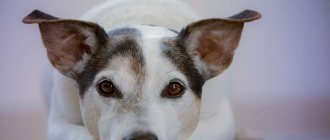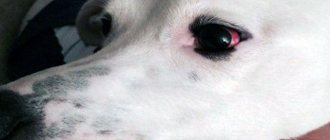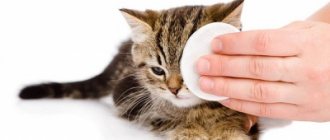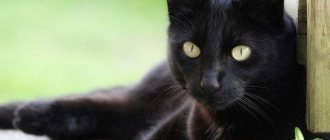First you need to earn the trust of your four-legged friend.
From the first days a kitten (or an adult cat) appears in the house, you need to talk to it affectionately, control your behavior - you cannot frighten or force the cat to do anything, but you must immediately establish house rules, which include hygiene procedures, and stick to them. Advice! If the pet was purchased from a breeder, it is worth asking what the kitten was trained to do.
It is quite possible that your pet already knows what maintaining eye hygiene means and knows how to behave correctly. An examination is always carried out before the procedure. Goodies are prepared in advance for encouragement. You can also use a favorite toy to reward efforts. You need to evaluate your pet's mood. If the cat is tired, or, conversely, overexcited, you should not burden it with such manipulations; it is better to wait for a more appropriate moment.
Is it possible and how to rinse a cat’s nose with saline solution?
If the cat is ready, you need to praise it and place it comfortably on the table or pick it up. First, they gently touch the muzzle, stroking and holding the head in one position so that the cat gets used to it. Be sure to speak to your pet in a friendly tone. Then they pull back the lower eyelid, inspecting the mucous membranes and praise again. An eye examination does not take much time and is quite easy. After this, you can begin cleaning the eyes and fur around them.
Preparation for procedures
Before washing your eyes, it is important to prepare the area, some tools, etc. The table is covered with a clean blanket, a diaper, and bright diffused light is provided: lamps, daylight from the window. Prepare in advance:
- cotton pads, clean lint-free wipes or the like;
- cotton buds;
- eye care product (lotion, ointment, gel or other necessary according to the situation);
- tweezers;
- treats.
After preparations, the cat’s condition and mood are assessed, an examination is carried out and the eyes are cleaned.
Special attention is paid to representatives of short-faced breeds. Since, due to the peculiarities of the anatomical structure of their skull, problems with the eyes and lacrimal glands often arise, such procedures must be carried out more carefully and carefully.
We put drops in the cat's eyes from a convenient pipette
Precautions
- Under no circumstances should alcohol solutions, antiseptics, or concentrates be injected into the eyes. This can cause a chemical burn to the surface of the eye.
- You cannot use plain water as a treatment - it disrupts the composition of the microflora of the eye and can dry out its surface.
- Do not use hot decoctions due to possible thermal burns.
- You should not use cotton wool or fibrous rags - the lint may get on the surface of the eye and may be difficult to remove.
- Do not use the same swab/cotton pad on both eyes. This way we can spread the infection from one eye to the other.
- Under no circumstances should treatment prescribed by a doctor be stopped without his knowledge and before the prescribed date.
How to properly care
The most common method is washing. They use various lotions, decoctions and infusions of medicinal herbs. If you have to take care of a cat’s sore eyes, your veterinarian will prescribe certain medications. Instillation of drops and application of medicinal gels and ointments are also often used.
Rinsing is carried out as follows: a small amount of the lotion used is applied to a clean swab (gauze, cotton-gauze, you can also use a napkin), but so as to moisten the fabric abundantly. Confidently holding a wet swab in your right hand (for left-handed people - in your left hand), hold the cat's head from the side with your other hand. With a precise, gentle movement, wipe the eyelids, removing dirt. You should move in one direction along the growth of the fur, that is, from the inner edge to the outer corner of the eye. The inner corner is wiped towards the nose. The same is done with the second eye.
If there are problems with the eyes, and the doctor has prescribed abundant washing, irrigation of the mucous membranes of the eye, you need to draw the required amount of the prescribed medicine into a syringe without a needle, pull back the eyelid, and, pointing the nozzle of the syringe at the mucous membranes, irrigate the affected areas under light pressure. To do this, the piston should be pressed in slowly and evenly. If you cannot control the pressure, it would be more rational to use a pipette, from which you carefully drop the medicine into the eye. Then gently wipe the leaked excess from the muzzle with a swab.
For your information! Be sure to wash your hands before rinsing or putting drops in your cat's eyes. It is also worth remembering that a separate disposable swab is used for each eye and, if necessary, changed several times during the procedure.
If your cat has been prescribed eye drops, all crusts and other contaminants must be removed before instillation. The eyelids are thoroughly wiped and the eyes are washed if necessary. If the stains are abundant and dried, they need to be soaked and then removed. Drops are instilled into the inner corner, onto the mucous membrane of the eye. To do this, hold the cat securely, pull back the lower eyelid in the same way as during examination, directing the spout of the bottle or pipette (depending on how the medicine is stored) to the desired place, lightly press on the body of the bottle, and a drop will be released. Having counted out the required amount, do the same with the second eye.
Ointments and gels are placed in the prepared eye, also behind the lower eyelid. You can squeeze it onto your finger or onto a glass rod, then apply it to your eye. This makes it more convenient and easier to dose the amount of medicine, as well as control the pressure and direction of putting the medicine. There is no need to squeeze the ointment into the eye directly from the tube. You can easily injure this delicate organ of vision, as well as disrupt the purity of the remaining medicine in the package.
After applying the ointment or gel, you need to massage the closed eye a little in a circular motion. This helps distribute the medication evenly and remove excess.
Eye lotion
Causes of discharge from a kitten's eyes
Discharge may appear when:
- injury;
- conjunctivitis;
- allergic reactions;
- hit by a foreign object;
- viral infection;
- helminthic infestation,
- turn of the century.
By the type of discharge you can determine the cause:
- In bacterial and viral diseases, the mucus is yellow and has a thick consistency.
- In case of allergies or injury, it is watery and transparent.
- When exposed to dust, it is transparent and turns brown when dry.
Dripping into the eyes
Required funds
At any veterinary pharmacy or pet store you can find various products for caring for your cat's eyes. You can also make some options at home yourself. To maintain eye hygiene use:
Lotions
These are specially manufactured liquid hygiene products based on purified water and herbal extracts. Lotions help clean the hair around the eyes, softening and removing crusts of dirt, and have a calming effect on the cat's eyes. The most commonly used lotions are calendula, chamomile, aloe and other beneficial plants. The cost of the product depends on the manufacturer, composition and volume of the bottle: from 60 to 480 rubles.
If the cat is accustomed to the procedures, there will be no problems with it
Eye drops
Manufacturers offer many options, depending on the diagnosis given to the cat. Drops are produced in small bottles with a convenient dropper tip, less often with a separate pipette.
These medications help relieve dry eyes, relieve inflammation, heal various lesions, and also fight viral and bacterial infections. Depending on the manufacturer, as well as the type of drops, they can be purchased at an approximate price of 40 to 550 rubles.
Special eye ointment
Ointments, gels
These are soft dosage forms that are prescribed by a veterinarian after examining the cat and making a diagnosis. They produce various similar medications designed for each individual case.
Used in the treatment of various injuries of the cornea, eyelids, and infectious diseases. They differ in composition and volume, so prices for such products also vary greatly: from 40 to 480 rubles.
Weak solution of potassium permanganate
Potassium permanganate (potassium permanganate)
Use only a very weak solution that is barely pinkish in color! Otherwise, you can cause irreparable damage to your eyes in the form of burns. Apply a fresh solution to a cotton swab and clean your pet's eyes as usual.
It can be stored for quite a long time when dry in a tightly closed bottle.
This is one of the most affordable eye wash options. The price of the drug is approximately 40 - 60 rubles. Can be bought at any pharmacy.
Furacilin solution
Furacilin solution
It is sold in tablets, which must then be dissolved in boiled water. If the owner decides to prepare the solution himself, it is important to monitor the concentration so as not to damage the pet’s eyes.
Tablets can be bought at a price of 60 - 90 rubles per package, the finished solution is sold for about 40 - 70 rubles.
At the same time, it is much more convenient to buy a ready-made product. The price will not be high, and you will save your time.
Saline
Saline solution (sodium chloride solution 0.9%)
Sold in any pharmacies in finished form. You can buy absolutely any packaging option, even one designed for droppers.
It is used to wash the eyes, like other similar products. You can purchase it at a price of 20 rubles. up to 280 rubles, depending on the purpose and volume of the bottle.
Boric acid
Boric acid
You can purchase the product in powder form and make your own eye wash. However, be careful. A solution that is too strong can harm your cat's eyes.
To do this, dissolve 1 teaspoon of boric acid powder in a glass (200 - 250 ml) of clean, cool water. The product costs 15–30 rubles per sachet (10 grams).
Chlorhexidine
Chlorhexidine for rinsing
When purchasing this product at a pharmacy, it is important to pay attention to the concentration of the active substance - they often sell either 0.05% or 0.01%. Any packaging for any purpose is suitable.
In addition to good cleaning properties, it also has a certain bactericidal effect.
If necessary, you can dilute the product yourself with purified water or saline to the desired level. Sold in almost any pharmacy at a price of 40 rubles. up to 90 rub.
Strongly brewed tea
Strong tea
The use of this method is often questioned, but many owners continue to wash their pets' eyes with black tea. In any case, you will not harm your pet.
You should use not packaged, but sheet, high-quality, settled and certainly without sugar.
Chamomile decoction
Herbal infusions (chamomile, calendula and others)
Decoctions are made from dried medicinal herbs and used in the same way as tea. Such products reduce pain, relieve inflammation to some extent, and also moisturize the eyes well.
It is best to purchase medicinal herbs at a pharmacy rather than collect them yourself. It is inexpensive, and the therapeutic effect will be guaranteed.
We wipe the cat’s eyes with a cotton pad after instillation.
Special wet wipes
They are very convenient to use, since the napkins are disposable, soaked in the required medicinal liquid and are immediately ready for use. It is only important to choose one without odor or with minimal aroma.
An additional convenience is that you can always take them with you on a long trip, for example to the country.
Distilled or boiled pure water
You can also easily use plain clean water to wash your pet's eyes. It is good for soaking and removing crusts and moisturizing the eyes.
Warning! To wash your cat's eyes, be sure to use cool liquids; do not use cold or very warm solutions. It is also important to monitor the freshness of the drugs.
Before washing, be sure to wash your hands so as not to introduce infection or other contaminants into your pet’s eyes.
Possible complications
If you refuse to visit the clinic and choose medications for your pet on your own, the disease takes on an advanced form and is dangerous due to its relapses. Fungal and parasitic skin lesions (mainly on the head) are possible, worsening the pet’s condition.
With an advanced form of infectious diseases and a kitten’s weak immunity, the pet will not be able to survive.
With eye disease and unqualified assistance, the damage affects the deep layers of the eye. In this case, the pet faces loss of vision.
Features of eye care depending on the cat breed
Some pets with short muzzles are prone to eye diseases. Also, representatives of such breeds have a shortened tear duct, which provokes the constant secretion of tears. Because of this, Persian cats, exotics, British and similar breeds always have wet tracks on their cheeks. In white cats, such discharge often darkens and turns brown.
What is a mat cutter for cats and how to use it
Such pets need to have their eyes examined more often, rinsed, removed dirty marks, and dried their fur with clean, dry wipes. If there are folds on the face, they are treated with talcum powder.
What to do at home
At home, it is necessary to strictly follow all doctor’s prescriptions, and ensure that medications are stored in accordance with the recommendations of the medical instructions.
To create conditions conducive to recovery, you need to provide your pet with a warm sleeping place in a quiet corner without drafts.
Nutrition is of great importance: the diet should be supplemented with vitamin supplements and ensure it is balanced.
Before carrying out the procedures, it is important for the owner to thoroughly wash their hands with soap and use separate wipes to clean each kitten’s eye of dirt. When used in the treatment or purification of solutions, the temperature of the liquids should not be lower than 37 degrees.
In the room where the kitten is located during treatment, the following are required:
- daily wet cleaning;
- replacing bedding on the animal's sleeping area;
- body temperature control;
- eye condition monitoring.
Expert advice
Veterinarians recommend not to neglect hygiene procedures for your pets’ eyes. It is worth assessing the condition of the visual organs every day. Rinse eyes only with clean, fresh suitable solutions.
It is important to morally support your pet during these simple but extremely important procedures, to praise and encourage. If you have the slightest doubt about your cat's health, you should not put off going to the veterinary clinic. It is important to tell the doctor exactly what worries you, answer his questions and do not hesitate to ask your own, if any.
A cat's eyes are a delicate and very important organ. Thanks to them, pets navigate their environment, so it is necessary to pay attention to caring for your pet’s eyes.
Prevention
To prevent such a situation, preventive measures are taken:
- The animal is kept in a clean room.
- If a kitten gets dirty, it must be washed.
- Be sure to wash the tray, since dirt accumulated there can cause various problems.
- If an animal is walking outside, it is carefully examined after returning home.
- It is recommended to prevent contact with street animals.
When souring occurs, it is necessary to determine the cause and take appropriate measures. Remember that only a veterinarian can make the correct diagnosis and prescribe treatment. Don't forget to maintain good ear hygiene.
Cautions
If the disease is serious, you cannot do without consulting a veterinarian. Only a specialist can prescribe appropriate medications and procedures based on your medical history and test results.
Otherwise - if street dust gets into the cat's eyes, for example - you can do a simple cleansing yourself. But remember a few important rules:
Not all water can be used for this.
There is definitely no tap water - the bleach and salts contained in it dry out the mucous membrane and destroy the natural microflora. In addition, such water may be contaminated. Rain and melt water are also not suitable. The liquid must be boiled and cooled!- Instead of cotton wool, use cotton pads: this is the only way to be sure that small fibers will not get under the eyelid and cause additional problems.
- For each eye - a new tampon, for each procedure - a fresh decoction.
- You cannot use chamomile infusion - it causes cats to lose hair.
- Rinse solutions should be warm, not hot or cold.
- If days go by and there is still no result, take your cat to the doctor.


